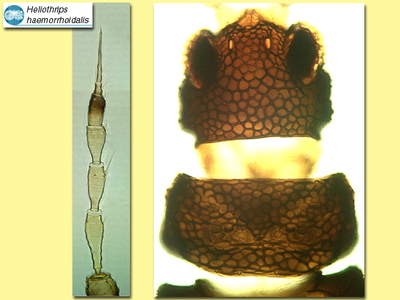Figures
Fig. 1 Antenna, head and pronotum
Fig. 2 Fore wing
Fig. 3 Metanotum and tergite VI and VII
Species
Heliothrips haemorroidalis Bouché
Biology
This slow-moving species breeds on the older leaves of a very wide range of plants, but usually not on plants with soft leaves. Males are very rare, having been found in good numbers only in southern Brazil. When disturbed the larvae bend the tip of the abdomen over the head and exude a drop of dark fluid.
Distribution
Found worldwide in the tropics and sub-tropics, also in greenhouses in temperate regions, and widespread in the moister areas of Australia
Recognition
Body colour dark brown, legs yellow but immature adults have the abdomen golden; forewings largely pale but with the posterior margin shaded. Antennae 8-segmented, segment VIII long and slender, about as long as segment IV; sensoria on segments III & IV simple. Body surface with strongly reticulate sculpture. Metanotum with a strongly sculptured median triangle. Forewings with setae minute and apex rounded. No long setae on the body.

Related species
Only two other species are placed in the genus Heliothrips, one from southern Brazil and the other from southern Africa (Mound & Marullo, 1997).



